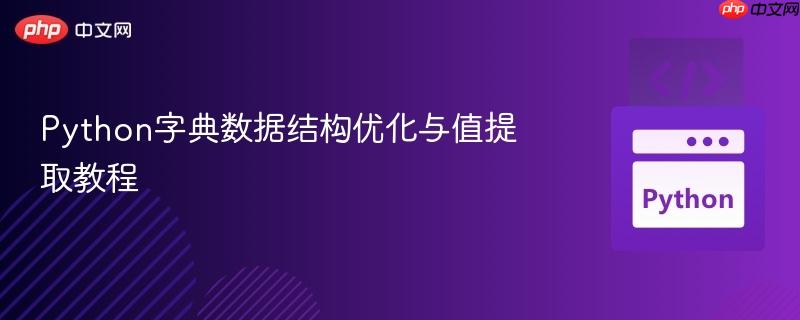
本文旨在指导python初学者如何优化字典数据结构,以避免不必要的嵌套,并实现高效的值提取与数据处理。通过分析常见的数据结构设计误区,我们将展示如何构建简洁且功能强大的字典,从而简化后续的数据操作,如排序,并提升代码的可读性和维护性。
在Python编程中,字典(Dictionary)是一种非常灵活且强大的数据结构,用于存储键值对。然而,不恰当的设计可能会导致数据难以访问和处理。本教程将通过一个生日管理示例,深入探讨如何构建一个高效的字典结构,并正确提取其值。
许多初学者在收集用户输入时,可能会无意中创建出过于复杂或冗余的数据结构。考虑以下场景,用户希望收集姓名和生日信息,并将其存储在一个字典中:
from datetime import datetime
dict_place = 1
birth_dict = {}
def date_key(date_string):
return datetime.strptime(date_string, "%d %b %Y")
while True:
name = input("Enter name of person: ")
birth_month = input("What month were they born?: ")
birth_day = input("What day of the month were they born?: ")
birth_year = input("what year were they born?: ")
birth_day = str(birth_day)
if len(birth_day) == 1:
birth_day = "0" + birth_day
birth_month = birth_month[0:3].capitalize()
birthdate = birth_day + " " + birth_month + " " + birth_year
# 问题代码:将字典作为值存储
birth_dict[dict_place] = {name: birthdate}
dict_place += 1
new_date = input(
"Do you want to enter another birthday?\n\nY for yes N for no\n\n"
)
if new_date.lower() == "y":
continue
else:
break
x = birth_dict.values()
print(x)在这段代码中,birth_dict 的结构最终会是这样的:
{
1: {'Jon': '01 Jan 2000'},
2: {'Jane': '15 Feb 1995'},
...
}这里存在两个主要问题:
立即学习“Python免费学习笔记(深入)”;
用户希望提取的只是生日字符串,以便进行排序,但当前的结构使得直接获取这些字符串变得困难。
为了简化数据访问和处理,我们应该重新思考字典的键和值应该代表什么。如果我们的目标是根据人名来查找生日,那么人名本身就应该作为字典的键,而其对应的生日字符串则作为值。这样,字典将直接映射姓名到生日。
优化的数据结构将是:
{
'Jon': '01 Jan 2000',
'Jane': '15 Feb 1995',
...
}这种结构清晰、扁平,且直接对应了业务逻辑:每个名字都有一个唯一的生日。
根据上述优化思路,我们可以修改代码中的字典赋值部分,并移除不必要的 dict_place 变量:
from datetime import datetime
birth_dict = {} # 不再需要 dict_place
def date_key(date_string):
return datetime.strptime(date_string, "%d %b %Y")
while True:
name = input("Enter name of person: ")
birth_month = input("What month were they born?: ")
birth_day = input("What day of the month were they born?: ")
birth_year = input("what year were they born?: ")
birth_day = str(birth_day)
if len(birth_day) == 1:
birth_day = "0" + birth_day
birth_month = birth_month[0:3].capitalize()
birthdate = birth_day + " " + birth_month + " " + birth_year
# 优化后的代码:直接将姓名作为键,生日作为值
birth_dict[name] = birthdate
new_date = input(
"Do you want to enter another birthday?\n\nY for yes N for no\n\n"
)
if new_date.lower() == "y":
continue
else:
break
# 现在,birth_dict.values() 将直接返回生日字符串
birthday_strings = list(birth_dict.values())
print("提取的生日字符串:", birthday_strings)现在,birth_dict.values() 将返回一个包含所有生日字符串的字典视图,例如 dict_values(['01 Jan 2000', '15 Feb 1995'])。将其转换为列表 list(birth_dict.values()) 即可得到 ['01 Jan 2000', '15 Feb 1995']。
一旦我们获得了纯粹的生日字符串列表,就可以利用 datetime 模块进行排序。排序的关键是将字符串日期转换为 datetime 对象,因为 datetime 对象可以直接比较。
from datetime import datetime
# 假设 birthday_strings 已经是 ['01 Jan 2000', '15 Feb 1995', ...]
# 如果是从上面的循环中获取,则:
# birthday_strings = list(birth_dict.values())
# 将生日字符串转换为 datetime 对象
datetime_birthdays = []
for date_string in birthday_strings:
try:
dt_obj = datetime.strptime(date_string, "%d %b %Y")
datetime_birthdays.append(dt_obj)
except ValueError:
print(f"警告: 无法解析日期 '{date_string}',已跳过。")
# 对 datetime 对象列表进行排序
sorted_birthdays = sorted(datetime_birthdays)
print("\n按日期排序的生日(datetime对象):")
for dt in sorted_birthdays:
print(dt.strftime("%d %b %Y"))
# 如果需要,也可以根据生日排序后,再获取对应的姓名
# 这需要将原始数据存储为 (datetime对象, 姓名) 的元组列表
birthdays_with_names = []
for name, date_string in birth_dict.items():
try:
dt_obj = datetime.strptime(date_string, "%d %b %Y")
birthdays_with_names.append((dt_obj, name))
except ValueError:
print(f"警告: 无法解析 {name} 的生日 '{date_string}',已跳过。")
# 根据 datetime 对象排序 (元组的第一个元素)
sorted_birthdays_with_names = sorted(birthdays_with_names)
print("\n按日期排序的生日(包含姓名):")
for dt_obj, name in sorted_birthdays_with_names:
print(f"{name}: {dt_obj.strftime('%d %b %Y')}")通过优化字典的数据结构,将姓名直接作为键,生日作为值,我们成功地简化了数据收集和提取过程。这种扁平化的设计不仅提高了代码的可读性,也使得后续的数据处理(如将生日转换为 datetime 对象并进行排序)变得更加直观和高效。在Python编程中,合理的数据结构设计是编写高效、可维护代码的关键。
以上就是Python字典数据结构优化与值提取教程的详细内容,更多请关注php中文网其它相关文章!

每个人都需要一台速度更快、更稳定的 PC。随着时间的推移,垃圾文件、旧注册表数据和不必要的后台进程会占用资源并降低性能。幸运的是,许多工具可以让 Windows 保持平稳运行。

Copyright 2014-2025 https://www.php.cn/ All Rights Reserved | php.cn | 湘ICP备2023035733号